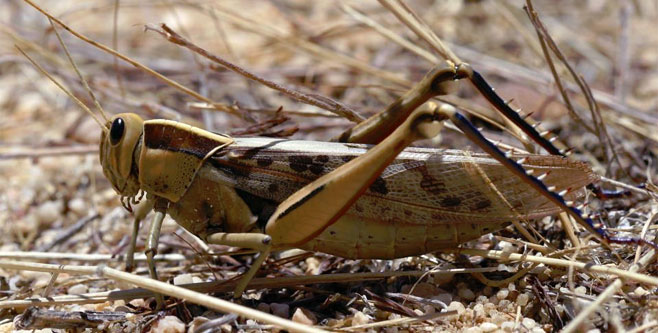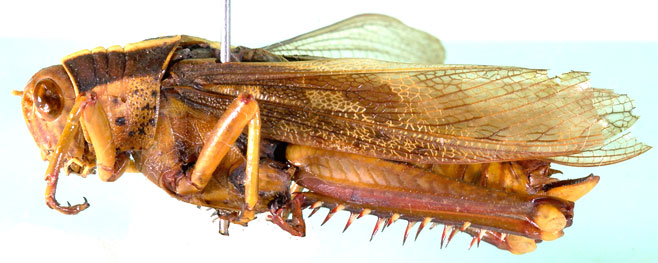|
Acanthacris ruficornis
Life
> Eukaryotes >
Opisthokonta >
Metazoa (animals) > Bilateria > Ecdysozoa
> Panarthropoda > Tritocerebra > Phylum:
Arthopoda > Mandibulata >
Atelocerata > Panhexapoda >
Hexapoda
> Insecta (insects) > Dicondyla > Pterygota >
Metapterygota > Neoptera > Polyneoptera > Anartioptera >
Orthopterida > Orthoptera >
Acrididae > Subfamily:
Cyrtacanthacridinae > Genus: Acanthacris
 |
|
Acanthacris ruficornis ruficornis unknown
gender,
Kogelberg Biosphere Reserve, Western Cape, South
Africa. [photo Axel Hochkirch ©] |
 |
|
Acanthacris ruficornis ruficornis female,
lateral view. [photo Daniel Otte ©] |
 |
|
Acanthacris ruficornis ruficornis
female, lateral view. [photo Singrid
Ingrisch ©] |
A pair of Acanthacris ruficornis mating (photo.
N. Larsen).
Acanthacris ruficornis is found virtually
throughout Africa south of the Sahara. It is eaten as food by people in the
northern parts of South Africa (Chesler 1938),
as well as in Congo and the Sahel (i.e. the band of arid savannah just south of
the Sahara) (van Huis
1996). Pallatable grasshoppers and locusts are normally cooked, fried or
roasted, after the legs and wings have been removed. In South Africa it is the
common large brown grasshopper found in people's gardens, often referred to
erroneously as a locust (the term locust should be applied only to swarming
species of grasshoppers).
According to Key (1930),
describing his finding on the biology of this species in the Cape Peninsula:
"The food of this large locust consists of the leaves of various trees, and
its habitat is fairly open ground planted with small trees. Port Jackson willows
are a favourite haunt. The season [of the adult] is from January to September
and the insect is very common in March. Oviposition have been observed from
January to June. The egg-pod is 42-50 mm. x 10 mm., and may be curved, though it
is sometimes quite straight. The frothy material in this case has very little
cohesive power, and practically no wall is formed, even in the soft soil
required for oviposition. Freshly turned over soil is especially favoured. The
number of eggs is very large, and very constant, the numbers counted in two pods
being 118 and 121 respectively. The eggs are laid in the lower 35 mm. of the
pod, and measure 6.5 x 1.5 mm. The eggs are covered with the usual frothy was,
but earth is never swept over the spot by the insect, which flies straight off
the hole. The first larvae appear in October. They are green when first hatched,
and usually remain greeen, but may become brown or pink according to the
background."
Chesler (1938) describes each of the seven instars (i.e.
stages between moults) that this grasshopper passes through during its
development. Her observations its phenology (i.e. stages of development over the
year) in Johannesburg are similar to those of Key (1930) for the Cape Peninsula.
She says: "There is a single generation a year. The hoppers appearing after
the first summer rains become adults in February and March. Adults were obtained
in the laboratory in April and remained alive in the laboratory throughout the
winter. The eggs deposited in April and May undergo a winter diapause and the
hoppers emerge at the beginning of the next season."
References
-
Chesler, J. 1938.
Observations on the biology of some South African Acrididae (Orthoptera). Transactions
of the Royal Entomological Society of London 87: 313-351.
-
Key, K.H.L. 1930. Preliminary
ecological notes on the Acrididae of the Cape Peninsula. South African
Journal of Science 27: 406-413.
-
van
Huis, A. 1996.
Text by Hamish G. Robertson
© |
